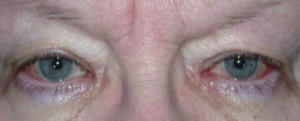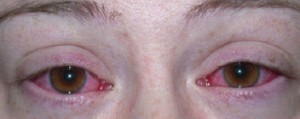
Pink Eye (Conjunctivitis)
Pink Eye (conjunctivitis) is an infection of the membrane over the white part of the eye. The blood vessels become dilated, making the eye(s) appear “pink.” Patients usually have symptoms of redness, tearing, and irritation of their eyes. A hallmark sign of pink eye is mattering or crusting of the eyes and eyelids in the morning. It may be one or both eyes, and often starts in one eye then shows up in the other within a few days. It occurs in patients of all ages: kids, adults, and the elderly.
Pink Eye is caused by exposure to a bacteria or virus that causes such infections. It may occur with a cold or flu. It is easily spread and very contagious. It may last from a few days to a few weeks. It may be contacted by sharing towels, utensils, or pillow cases with others. It can be treated with antibiotic drops. It may be necessary to stay off work or school for a few days until the infection is controlled. If it is a viral infection, there are no known effective treatments and the infection has to run its course and resolve on its own. Some severe cases (“EKC”) may last up to months.
If you or someone you know has signs or symptoms of pink eye it is best to see an ophthalmologist or optometrist as soon as possible. Sometimes early treatment eliminates symptoms and prevents the spread of the illness.
 This image is of an elderly woman who recently presented to our office with a 2 day history of redness, watering, and mattering of her eyes. She was diagnosed with infectious conjunctivitis or “pink eye.”
This image is of an elderly woman who recently presented to our office with a 2 day history of redness, watering, and mattering of her eyes. She was diagnosed with infectious conjunctivitis or “pink eye.”
 This image is another case of Pink Eye (Conjunctivitis)
This image is another case of Pink Eye (Conjunctivitis)